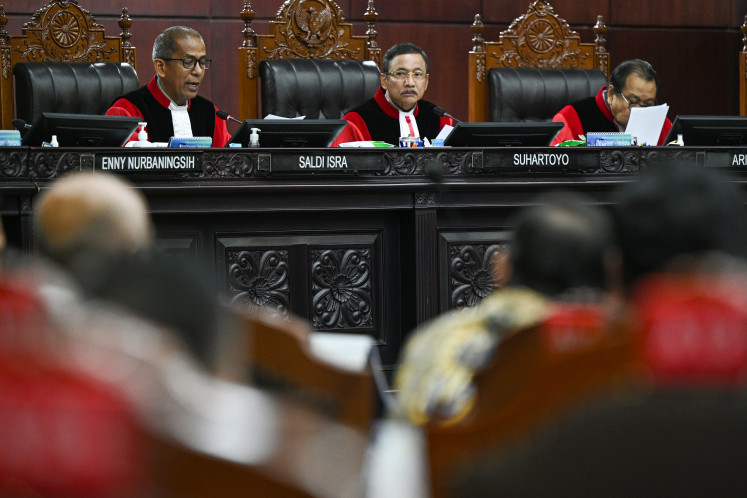Popular Reads
Top Results
Can't find what you're looking for?
View all search resultsPopular Reads
Top Results
Can't find what you're looking for?
View all search resultsIndonesia’s coral damage critical
Tourists who are on seaside vacations and want to go underwater to enjoy natural submarine features may take them for granted
Change text size
Gift Premium Articles
to Anyone
T
ourists who are on seaside vacations and want to go underwater to enjoy natural submarine features may take them for granted. Worse, careless tourism activities have been named as among the major contributors to the global decline of coral reefs.
The Bahamian-flagged cruise ship MV Caledonian Sky, which was chartered by a British tour company, made international headlines when it ran aground in the near-pristine waters of Raja Ampat, West Papua, in March. More than 19,000 square meters of coral were damaged, according to officials.
Indonesia is home to 559 species of coral inhabiting about 2.5 million hectares in the sea.
The most recent monitoring by the Indonesian Institute of Science (LIPI) suggests only 6.39 percent remained in an excellent condition.
Since 1993, LIPI has been routinely monitoring the condition of coral reefs in Indonesia, a country rich in marine biodiversity, suggesting that the destruction rate during the 2015 to 2016 period was the most threatening, according to a LIPI report released on Wednesday.
LIPI also blames the “seemingly inevitable” impact of climate change as a major cause of the bad coral condition.
Based on routine monitoring in 108 location in Indonesia, LIPI found 35.15 percent of the coral reef in very bad condition in 2016, about a 5 percent increase from the previous year.
In Indonesia, irresponsible fishing committed by both modern and traditional fishermen has also played a major role in the destruction of coral.
Suharsono, a senior marine scientist with LIPI, recently visited the remote Balang and Balangan islands in South Sulawesi after learning the condition of coral reef was badly damaged there.
When he talked with fishermen living on the islands, Suharsono found out they were still using fish-bombs to harvest catch.
He said he was flabbergasted by the explanation of the islands’ village head who blatantly admitted he had permitted the destructive fishing method to be carried out in his region.
“They were allowed to use fish-bombs as long as they routinely paid some money to the local head,” Suharsono told The Jakarta Post Wednesday.
He recalled a statement of the head: “No matter how many fish-bombs we use every day, fish are still abundant in our sea.”
Suharsono said the head was completely wrong. “Such practices totally destroy coral reef.”
According to the study, coral in excellent condition could only be found in two locations: the sea located west of West Kalimantan province and around the pristine Lusipara Island in the Banda Sea.
LIPI also noted that the worsening condition of coral reef in Indonesia also took the form of what it considered a “massive” coral bleaching, which was caused by the rising sea temperatures triggered by the El Niño climate phenomenon that occurred in Indonesia last year.
LIPI Oceanography Research Center head Dirhamsyah said coral bleaching would be more massive in the future because of the combination of climate change and planet warming.
According to LIPI’s study, coral reefs in waters off Sumatra and the southern part of Java are the most prone to bleaching. In the western part of Sumatra, coral reefs are experiencing extreme temperature change caused by the Indian Ocean Dipole (IDO) phenomenon, when the western part of the ocean becomes warmer and then alternately colder than the eastern part of the ocean.
Rizya Ardiwijaya, a coral reef specialist at an environmental NGO, the Nature Conservancy, argued there was no single coral expert who could firmly forecast the condition of coral reefs in the future.
Apart from causes like El Niño and global warming, coral’s condition also depended on its resiliency, he explained.
“Naturally, they have resiliency to cope with changing reality. A resilient coral can hopefully survive in any specific harming condition that it experienced before,” Rizya said.










